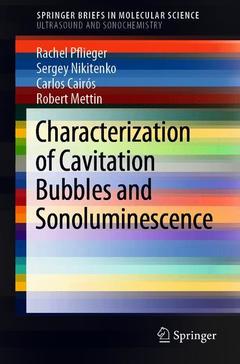Characterization of Cavitation Bubbles and Sonoluminescence, 1st ed. 2019 Ultrasound and Sonochemistry Series
Auteurs : Pflieger Rachel, Nikitenko Sergey I., Cairós Carlos, Mettin Robert

This book presents the latest research on fundamental aspects of acoustic bubbles, and in particular on various complementary ways to characterize them. It starts with the dynamics of a single bubble under ultrasound, and then addresses few-bubble systems and the formation and development of bubble structures, before briefly reviewing work on isolated bubbles in standing acoustic waves (bubble traps) and multibubble systems where translation and interaction of bubbles play a major role. Further, it explores the interaction of bubbles with objects, and highlights non-spherical bubble dynamics and the respective collapse geometries. It also discusses the important link between bubble dynamics and energy focusing in the bubble, leading to sonochemistry and sonoluminescence.
The second chapter focuses on the emission of light by cavitation bubbles at collapse (sonoluminescence) and on the information that can be gained by sonoluminescence (SL) spectroscopy, e.g. the conditions reached inside the bubbles or the nature of the excited species formed. This chapter also includes a section on the use of SL intensity measurement under pulsed ultrasound as an indirect way to estimate bubble size and size distribution.
Lastly, since one very important feature of cavitation systems is their sonochemical activity, the final chapter presents chemical characterizations, the care that should be taken in using them, and the possible visualization of chemical activity. It also explores the links between bubble dynamics, SL spectroscopy and sonochemical activity.
This book provides a fundamental basis for other books in the Molecular Science: Ultrasound and Sonochemistry series that are more focused on applied aspects of sonochemistry. A basic knowledge of the characterization of cavitation bubbles is indispensable for the optimization of sonochemical processes, and as such the book is useful for specialists (researchers, engineers, PhD students etc.) working in the wide area of ultrasonic processing.
Chapter 1: Single Bubble Dynamics, Multi-Bubble Dynamics and Interactions, Object Interaction, Collapse Geometries and Consequences.- Chapter 2: MBSL Spectra Including Metal and C2 Emission, Bubble size Measurements etc.- Chapter 3: Relevance of Chapters 1 and 2 in Sonochemistry, Sonochemiluminescence, etc.
Dr. Robert Mettin (PhD in Physics in 1996) is a member of the permanent research staff and has headed the Christian Doppler Laboratory for Cavitation and Micro-Erosion at the DPI for 7 years. He has worked experimentally and theoretically on nonlinear dynamics, acoustics, fluid dynamics and optics. His main research activities include ultrasound and acoustic cavitation, bubble and drop dynamics, surface cleaning, sonochemistry and sonoluminescence.
Dr. Carlos Cairós earned his PhD in Chemistry in 2010, and he has worked on acoustic cavitation and bubble dynamics, sonoluminescence and sonochemistry at the DPI for 5 years. His main research interests focus on the links between bubble dynamics and sonochemistry, sonoluminescence spectroscopy, especially the connection between multibubble sonoluminescence (MBSL) and single-bubble sonoluminescence (SBSL), and the arising applications in sonochemical reactor design.
Dr. Sergey Nikitenko earned his PhD in Chemistry in 1981. Currently he is a Director of Research at CNRS France. Since 2008 he has been Head of the Laboratory of Sonochemistry in Complex Fluids at Marcoule Institute for Separation Chemistry (ICSM). His research focuses on sonochemistry, sonoluminescence, synthesis of nanomaterials, inorganic chemistry, and radiochemistry.
Dr. Rachel Pflieger (PhD in Physical Chemistry in 2006) has been pursuing research at the ICSM sonochemistry lab since 2008. She has been working on single-bubble sonoluminescence, SBSL (in the framework of a collaboration with Max-Planck Institute of Colloids and Interfaces of Potsdam, Germany) and on multibubble sonoluminescence, MBSL (at ICSM). Her main research interests are sonoluminescence spectroscopy, bubble size estimation based on sonoluminescence intensity measurements, and the investigation of the links between sonoluminescence and sonochemistry.Describes physical and chemical characterizations of acoustic cavitation bubbles
Presents new image material of sonoluminescing bubbles
Focuses on the latest literature on multibubble sonoluminescence and on the links between sonoluminescence and sonochemical activity
Date de parution : 02-2019
Ouvrage de 74 p.
15.5x23.5 cm



